Citizens of the Month: The Downtown Soccer League board
I am a little late to this party but still wanted to recognize the 30 years of service — as of last year — that our neighbors on the Downtown Soccer League board have given to Tribeca. It’s hard to imagine life with kids here minus the leagues: for my family and I know hundreds and hundreds of others, the DSL not only gave our city kids a chance to play sports, but created lifelong friendships. Especially for kids whose school lives take them all over the city, having a crew of pals and teammates in Tribeca is what makes this place feel like home.
I chatted with outgoing president Eileen Connaughton Montague — the new president as of January is Mark Lee — and president emeritus Bill Bialosky on the history and current status of the league.
How did the league start?
Bill: The one thing important to know is we took the Downtown name before Downtown did. Everyone in Lower Manhattan began playing at the JJ Walker field [on Leroy and Hudson], before PS 234 was built, before Lower Manhattan really changed. When 234 happened, and the sites in BPC became a grass field — they used to be tennis courts — that’s when the group left JJ Walker and came downtown, and in ’93 started the Downtown Soccer League.
The thing that was most remarkable is it worked just like every other suburban effort — with telephone trees and big group meetings. It’s amazing we could even do it without the internet. Don Schuck was our first president; he passed the baton to me after seven years, when we digitized. That first website allowed us to grow from 600 kids to more than 2000. I don’t think a parent-volunteer-run organization could do it without that tool.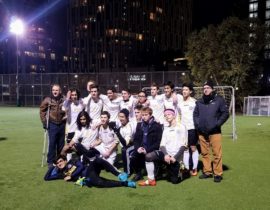
Eileen: It’s incredible to think that 30 years ago we started with 300 kids. We now have 2178 kids on 180 teams with 400 volunteer coaches. We also have 60 high school assistant coaches, as well as 12 junior referees — a program we built after covid when it was hard to get paid referees. Now 40 percent of our games are reffed by high schoolers.
What is the league’s goal?
Eileen: The best thing about the league is the focus on community and building community through soccer. And we want to keep that opportunity in the players’ lives for as many years as possible. The past five years we have worked hard to keep our high school program alive by making it easy and fun for kids to play — most leagues don’t have it. There’s so much pressure to be more competitive and it’s great to have something that is just fun.
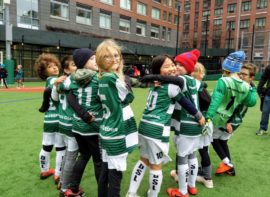 Really the ultimate goal is for the kids to be able to jump into a coed soccer game on the quad in college and have some fun. We know there are kids on travel teams — and we love having those kids as players too — but for those other kids who aren’t playing at the highest competitive level, we want to spend some resources there.
Really the ultimate goal is for the kids to be able to jump into a coed soccer game on the quad in college and have some fun. We know there are kids on travel teams — and we love having those kids as players too — but for those other kids who aren’t playing at the highest competitive level, we want to spend some resources there.
Bill: The success of our league foreshadowed but also facilitated the transformation of Lower Manhattan. It’s about families building community and making community matter and knitting a community together. We do it even better than folks in the suburbs, if you ask me, because we do it on foot. As we head to the fields, we pass our neighbors, we pass our friends — I don’t think there’s anything else quite like it in the world.
Why do you think the league has been so successful?
Bill: I think we have done a really good job of resisting farming out or outsourcing coaching. We have made the volunteer aspect of the league a priority. The idea of volunteering and rec is that everyone is involved. It’s about playing sport together and making community and providing everyone with that same opportunity to be outside and exercise.
Was it a fight to create the fields in Battery Park City?
Bill: Not really. That field was created as a temporary field, on sites 43 and 44, and then 9/11 happened. And though the league had been using the field until then, the city needed to use it as a staging ground. Don did an amazing job of keeping the games going by moving us up to Chelsea Waterside Park in Hudson River Park — it became the safety valve for DSL.
After 9/11, the state deeded the development sites over to create permanent field space. [Originally, Battery Park City planned two buildings on that site.] But the thing we did have to fight for was moving from grass to turf. At the beginning of the Battery Park City Authority’s sustainability program, grass seemed like the “right” thing, but what we learned was that mud was dangerous; by moving to turf we could create 80 percent more playing time; and we had to — this was the only resource we had. We have 100 kids per hour on it. There’s no field in the country that has that many kids playing on it. That’s 1200 kids a day — it’s just remarkable. That’s what helped the authority realize it was the right thing to do.
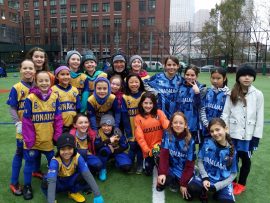 Tell me about the girls division.
Tell me about the girls division.
Eileen: In 2012, Laura Benoist and I were playing one evening with the DSL moms group and as we walked home, we said to each other, what a shame our girls can’t play with other girls. We loved playing with women. We both played college soccer and we knew it made a difference. We asked to meet with the DSL board that year; then there was a grand total of 15 10-year-old girls playing soccer. The board told us we could launch a girls division, but we had to do it all ourselves.
By the next year we had a girls division. Now we have 800 girls playing starting at age 7.
Girls can still play on the coed teams, but we know their play improves on an all-girls team. Before the girls division started, they were dropping out of the league as early as fifth grade. Plus all the other city rec leagues had a girls program. They knew it worked.
What’s the biggest challenge for the league moving forward?
Bill: Field space. We should never stop adding kids because we have run out of field space. The city has reaped the benefits of Downtown becoming a residential community, now we have to have a metric for creating park space for every kid we add as a resident. As a community we need to stay focused for where our next field will be, so we don’t ever have to say, “no, you can’t come play with us.”
And maintaining parent participation has to be the second biggest challenge. As life gets more and more expensive in New York, and parents are both working, there is a continued push to say, “Can I pay someone to do this for me?” But the legacy of keeping parents involved is so important. As long as the leadership of DSL stays committed to it, we will always find the parents.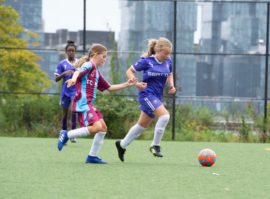
How much work is it exactly?
Eileen: It’s constant. It starts in March and doesn’t stop until December, then it starts again two months later. Rostering, parent emails, placing coaches — thank goodness we have such a strong board. Plus they are moms and dads and doing this on top of all that — and they have jobs! It’s amazing, really, what our volunteers do.
Bill: Monumental. Eileen put in an immense number of hours, but she has done such a good job to get more volunteers involved to break the work into smaller pieces. A coach is putting in 10 weeks of six to eight hours a week.
What’s one thing you are proud of?
Eileen: What keeps me coming back is the community aspect, and we really saw the impact of DSL and the power of DSL during covid. We put a lot of measures in place so we could keep kids playing the whole time in 2020. And we saw how important it was for children and even the adults. I got more than 100 emails from parents at the end of the season saying they were so grateful. It was a hard decision and a brave decision to keep playing — and it wasn’t easy to pull off. But it was so important.
It also ended up being our most successful year. The turnout was amazing. Attendance was at 95 percent. We also hired 60 teenage workers to check people at the gates. It was a big deal for those kids because most of them were remote and having a difficult time. It gave them something to do away from home.
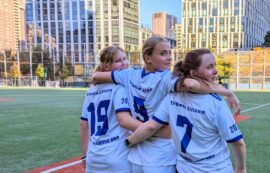
Bill: I am most proud that the league is still going! And what makes me the happiest is when kids come up to me and say hi and I don’t recognize them because they are now adults, and they are standing there with a friend who was on their soccer team 10 years ago. We are really really lucky to live in this great community. The season is only 10 weeks long and it is probably the best way to meet people in your neighborhood and make the most friends.
Anything else?
Eileen: We have to thank Battery Park City for preserving the fields, for being there and giving us all those permits. I think a lot of people stay in downtown Manhattan because of these leagues. Bringing a little one to play in your backyard, watching your children play with your neighbors’ children — it’s part of what makes this community so strong.
Bill: A important message for me is, never pull up the drawbridge on this league. The whole concept is for anyone and everyone who is a part of our community — who lives or goes to school below Canal Street — we must find a way to accommodate. It’s this inclusivity that makes us so strong.







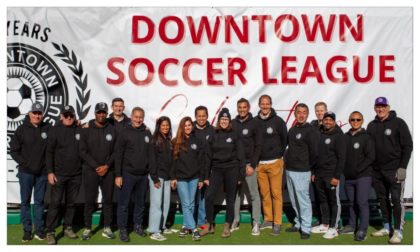
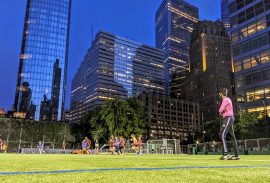
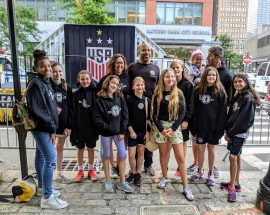







My son has been playing DSL since he was 5 (now 17). It’s always the team he wants to return to (no matter how busy he is with other teams). I don’t know what we would have done without them during COVID- it was such a great outlet for the kids and relief for parents. I am a nurse practitioner and worked in a Covid ICU for months – and thought DSL did an amazing job keeping kids safe and getting them outside. I am always so thankful for them but never more during that really difficult year. Thank you for all you do for the community.